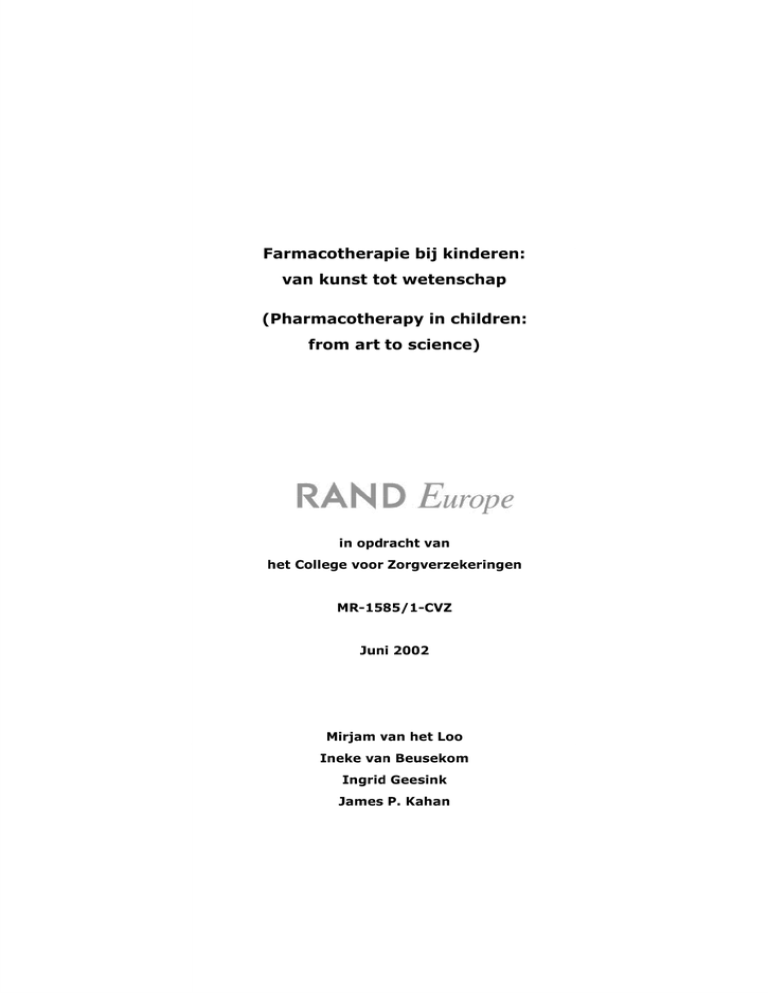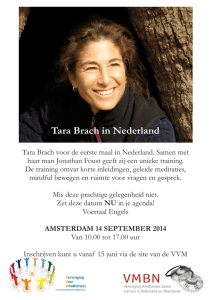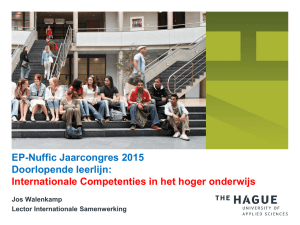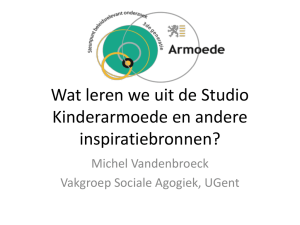Document 12891398
advertisement

Voorwoord Op verzoek van het College voor Zorgverzekeringen (CVZ) heeft RAND Europe een onderzoek uitgevoerd naar farmacotherapie bij kinderen. Dit onderzoek is erop gericht om: (a) inzicht te verwerven in de knelpunten die bestaan omtrent farmacotherapie bij kinderen; en (b) oplossingsrichtingen voor die knelpunten aan te dragen. Wat betreft de knelpunten wordt een onderscheid gemaakt tussen medischinhoudelijke kennislacunes en knelpunten die ontwikkeling en uitvoering van een goede farmacotherapeutische zorg aan kinderen in de weg staan. Met dit onderzoek willen wij bijdragen aan de verbetering van de farmacotherapeutische zorg aan kinderen door veranderingen aan te bevelen ten aanzien van de context waarbinnen geneesmiddelengebruik bij kinderen tot stand komt en door een aanzet te geven tot meer onderzoek naar specifieke geneesmiddelen. Voor meer informatie over CVZ en over dit onderzoek kunt u contact opnemen met: Mw. J.J.H. Waterreus, huisarts-epidemioloog College voor Zorgverzekeringen Secretariaat BOG Postbus 396 1180 BD Amstelveen Tel: +31-20-347.55.18 Fax: +31-20-347.57.24 Email: YWaterreus@cvz.nl Voor meer informatie over RAND Europe kunt u contact opnemen met de auteurs van dit rapport: RAND Europe Newtonweg 1 2333 CP Leiden Tel: +31-71-524.51.51 Fax: +31-71-524.51.91 Email: reinfo@rand.org www.randeurope.org iii Inhoudsopgave Voorwoord ................................................................................................iii Inhoudsopgave .......................................................................................... v Dankwoord ..............................................................................................vii English summary: Prescribing for Children: From Art to Science ....................... x Hoofdstuk 1: Inleiding ................................................................................ 1 1.1 Achtergrond ................................................................................... 1 Hoofdstuk 2: Methoden van onderzoek ......................................................... 7 2.1 Inleiding ........................................................................................ 7 2.2 Oriënterende gesprekken ................................................................. 9 2.3 Literatuuronderzoek ...................................................................... 10 2.4 Vragenlijsten ................................................................................ 13 2.5 Interviews.................................................................................... 16 2.6 Inhoudelijke commissie en scorelijsten............................................. 18 Hoofdstuk 3: Resultaten: de context .......................................................... 21 3.1 Inleiding ...................................................................................... 21 3.2 Knelpunten .................................................................................. 22 3.3 Oplossingsrichtingen...................................................................... 27 3.4 Naar een samenhangend pakket van maatregelen ............................. 38 3.5 Implementatie van de oplossingsrichtingen....................................... 41 Hoofdstuk 4: Resultaten: medisch-inhoudelijk ............................................. 55 4.1 Inleiding ...................................................................................... 55 4.2 Het literatuuronderzoek ................................................................. 55 4.3 Vragenlijsten en interviews............................................................. 57 4.4 Scorelijsten .................................................................................. 58 4.5 Kennisontwikkeling........................................................................ 61 4.6 Kennisverspreiding ........................................................................ 62 4.7 Onderzoeksbehoefte ...................................................................... 63 4.8 Korte bespreking resultaten per groep geneesmiddelen ...................... 64 4.9 Conclusie ..................................................................................... 66 Hoofdstuk 5: Conclusie en discussie........................................................... 67 5.1 Conclusies.................................................................................... 67 5.2 Discussie ..................................................................................... 71 Literatuurlijst........................................................................................... 77 Bijlage A: Lijst van geïnterviewden ............................................................. 79 Bijlage B: Vragenlijsten en groepsinterviews................................................ 81 Bijlage C: Vragenlijsten inhoudelijke commissie............................................ 96 Bijlage D: Voorstel voor landelijk kinderformularium en compendium .............104 v Dankwoord Wij willen graag iedereen bedanken die heeft bijgedragen aan de uitvoering van dit onderzoek naar farmacotherapie bij kinderen. Ten eerste willen wij Yolande Waterreus en Nicolien Wieringa van het College voor Zorgverzekeringen bedanken voor de begeleiding die zij vanuit het College aan het project hebben gegeven. Ook bedanken wij Eric Kalter van CVZ voor de inspirerende wijze waarop hij leiding heeft gegeven aan de bijeenkomsten van de inhoudelijke commissie. De leden van de inhoudelijke commissie willen wij danken voor hun kritische, opbouwende commentaar ten aanzien van de opzet van het onderzoek, hun bijdrage aan de evaluatie van de knelpunten en oplossingsrichtingen en hun reacties op het concept-eindrapport. De inhoudelijke commissie bestond uit de volgende leden: • Prof.dr. J.N. van den Anker, Sophia Kinderziekenhuis Rotterdam, Pediatric Pharmacology Network, European Network for Drug Investigation in Children • Dr. H. van Bronswijk, Nefarma • Dr. K. Burggraaf, Paediatric Pharmacology Network • Drs. A.C. van Grootheest, Stichting LAREB • Dr. M. de Hoog, Sophia Kinderziekenhuis • Prof.dr. M. Offringa, Dutch Cochrane Centre, Paediatric Pharmacology Network • Mw.dr. C.M.A. Rademaker, Wilhelmina Kinderziekenhuis • Dr. J.A.J.M. Taminiau, Amsterdams Medisch Centrum • Dr. A.G. Vulto, Academisch Ziekenhuis Rotterdam • Prof.dr. J.M. Wit, Leids Universitair Medisch Centrum Prof.dr. J.K. Buitelaar, dr. M.O. Hoekstra en mw.drs. A.C.G. Voordouw bedanken wij voor hun bijdrage aan de eerste bijeenkomst van de inhoudelijke commissie; helaas konden zij wegens tijdgebrek niet bij latere bijeenkomsten aanwezig zijn. Ook drs. I. Wolff en dr. M. ten Ham die de bijeenkomsten namens het Ministerie van VWS bijwoonden, danken wij voor hun inzet. Verder willen wij een ieder die wij in de loop van het project hebben geïnterviewd hartelijk danken voor zijn of haar waardevolle bijdrage aan dit project. De lijst van geïnterviewde personen is opgenomen in Bijlage A. Wij willen Annette Kerste bedanken voor haar commentaar op de vragenlijsten die aan kinderartsen, huisartsen en apothekers zijn toegestuurd. Verder willen wij de reviewer van het rapport, Han de Vries, danken voor zijn waardevolle commentaar op een eerdere versie van dit rapport. Tenslotte willen wij onze collega's, Janneke Vader en Rita Mangione-Smith, die in een eerdere fase bij dit onderzoek waren betrokken, danken voor hun grote inzet. vii Gebruikte afkortingen BOG = Commissie BeleidsOnderzoek Geneesmiddelen van het CVZ CBG = College ter Beoordeling van Geneesmiddelen CCMO = Centrale Commissie Mensgebonden Onderzoek CVZ = College voor Zorgverzekeringen EMEA = European Medicines Evaluation Agency ENDIC = European Network of Drug Investigation in Children ICH = International Conference on Harmonisation LAREB = Stichting Landelijke Registratie en Evaluatie Bijwerkingen METC = Medisch Ethische Toetsings Commissie NEFARMA = Nederlandse Vereniging van de Research-georiënteerde Farmaceutische industrie NHG = Nederlands Huisartsen Genootschap NVK = Nederlandse Vereniging voor Kindergeneeskunde NSCK = Nederlands SignaleringsCentrum Kindergeneeskunde PPN = Pediatric Pharmacology Network VWS = Ministerie van Volksgezondheid, Welzijn en Sport WINAp = Wetenschappelijk Instituut Nederlandse Apothekers WMO = Wet Medisch Onderzoek bij mensen ZON/MW = Zorg Onderzoek Nederland/Medische Wetenschappen ix English summary: Prescribing for Children: From Art to Science Introduction It is generally acknowledged that a substantial proportion of prescriptions for children are written in the absence of sound scientific evidence regarding the effectiveness of the drugs. Recent publications have demonstrated that for many drugs, the majority of prescriptions for children are unlicensed or off-label. Clinical research on children in order to obtain this scientific evidence would be expensive, pose ethical issues, and be complicated (involving assessments of dosage level, side effects, and considerations of different age levels). Because research to obtain such evidence for use in the paediatric population is not required for a new pharmaceutical product to be licensed, it is understandable (even if regrettable) that the manufacturers do not engage in this research. In the Netherlands, steps have been taken to address this potential problem. In 1997, the Paediatric Pharmacology Network was founded to stimulate clinical research on paediatric prescriptions, but this network has scant personnel and financial resources. In 2001, the Health Inspectorate (Inspectie voor de Gezondheidszorg) called for research, especially on psychoactive drugs, and called for the establishment of a database of drug-related incidents in the paediatric population. Similar calls have been issued by, among others, the European Agency for the Evaluation of Medicinal Products, resulting in a European Network for Drug Investigation in Children. The European Commission has also shown awareness of the issue. However, results of this movement are slow in coming. The Dutch Health Care Insurance Board (College voor Zorgverzekeringen, or CVZ) issued a call for tenders in late 2000, requesting a study to prioritise research needs in the area of prescribing for children. RAND Europe responded with a proposal to conduct a review of the scientific literature on this topic and to disseminate a survey to family practitioners, paediatricians and pharmacists to obtain their perceived needs for clinical research in this area. The study was to be guided by a group of experts in the field of paediatric prescription, representing the various medical specialities involved. This proposal was accepted by CVZ, and the study commenced. However, as the project unfolded, the guidance group expressed the opinion that the original research question was incomplete, because the problems in prescribing for children could not be resolved by clinical research alone; other issues were also important. In x response, RAND Europe proposed, and the CVZ accepted, a modified study to identify the barriers to effective prescribing for children, with an emphasis upon the absence of good clinical research within those barriers. In the remainder of this summary, we will discuss the study as modified. The goals of this study are threefold. • The first is to bring to awareness and to assess the importance of barriers to optimal pharmacotherapy for children. Here, we take the term barriers in its broadest sense, to include shortcomings in knowledge, communications, individual caregiver and patient behaviour, and the organisational structure of the health care delivery system. • The second goal is to identify possible solution directions—or recommendations for change—that can reduce these barriers. These solution directions are also assessed in terms of their likelihood of reducing barriers, with the assessment based on the likelihood of the solution being successful for the number and importance of the barriers to which they would be addressed. o A subgoal of the second goal is to assess the extent to which a new organisation focussing on prescribing for children, would be one of the promising solution directions. • The final goal of the study reflects back to the original purpose of the project, and is to assess the extent to which clinical research is a useful solution direction, and which aspects of such clinical research (specific drugs, clinical condition addressed, dosage, side effects, etc.) are most important. Methods The study began with an examination of the literature on paediatric prescriptions and with a series of interviews with different stakeholders in the health care delivery system. This resulted in a survey sent to family practitioners, paediatricians and pharmacists, followed by a second round of (group) interviews with (a different set of) stakeholders. These led in turn to a set of quantitativelyposed questionnaires sent to the guidance committee assessing the discovered barriers, possible solution directions, and clinical research priorities. The results of these questionnaires were presented and discussed in a meeting of the guidance committee. Orienting interviews. In parallel with the review of the literature, a series of orienting interviews were held with organisations that have an important role in xi health care for children. The purposes of these interviews were to learn what the roles of these organisations with respect to paediatric care were and to gain stakeholder perspectives on the possibility of a new organisational structure. Review of the literature. The review of the literature followed the wellestablished methods for systematic reviews. Search terms included medication, p(a)ediatric, child, off-label, unlicensed, pharmacol*, clinical trial and review. The search was constrained by examination of the prevalence of certain diseases among children and the extent to which certain medications are prescribed for children. To limit the scope of the study, articles regarding prescription for neonates and children under the age of 3 months were excluded. On the basis of these criteria, the following disease categories were examined: • Allergies and immunological disorders (especially asthma and allergic rhinitis) • Infections (otitis media, respiratory disorders and urinary tract infections) • Endocrinological disorders (diabetes, growth hormone deficiency, congenital adrenal hyperplasia, hypothyroidism) • Psychiatric disorders (ADHD, autism, depression, enuresis) • Neurologic disorders (epilepsy) From an original set of 30000 "hits", a filtering process reduced the set of articles examined to a more manageable but still sizeable 600. Postal survey. On the basis of the literature review and the advice of some members of the guidance committee, a survey was designed and distributed. The survey selected 22 medications on the basis of one or more of the following criteria: (1) they were in the top-10 of medications prescribed for children, (2) they were typically prescribed off-label, or (3) the literature review identified them as "hot" items. For each of the medications, the survey asked whether the respondent prescribed it for children, whether they believed they were adequately informed regarding dosage, side effects and interactions with other medications, and for which age groups they would like to have more information. Respondents were also given the opportunity to add up to five medications not on the list of 22 that they believed were problematic for children. Finally, respondents were asked to prioritise the (22 to 27) medications in terms of their need for clinical research. The postal survey was suitably tailored for family practitioners, paediatricians and pharmacists, and distributed to a sample of 200, 450 and 200 of each group, respectively. The response to this survey was disappointingly small, with a 27.5 xii percent response rate for the paediatricians, but only 12.5 percent for the other two groups (in spite of follow-up attempts for some of the addressees). Given this response, statistical analyses were performed only for the paediatricians. Second round interviews. To obtain further insight into research priorities and to identify other forms of barriers, a second round of interviews were conducted, with a different set of individuals than in the first set. Two types of interviews were performed, medical-content interviews from a total of 13 medical specialists and pharmacists and policy interviews with a total of 9 policymakers from the ministry of health, the pharmacological industrial sector, and self-standing organisations concerned with medications and paediatric care. These interviews were used to identify the various barriers to optimal paediatric prescriptions and to get ideas how to resolve the barriers. The starting points for the interviews were the results of the orienting interviews, the literature review and the survey. The interviews were analysed to identify the major barriers mentioned, which were then categorised (see results subsection, below). On the basis of ideas presented in the interviews and the literature, plus the knowledge of the research team, a set of possible solutions to the barriers were assembled and also categorised. The barriers and solutions were presented to the guidance committee for discussion and refinement. Quantitative questionnaire. The refined lists of barriers and solution directions were put into a questionnaire given to the members of the guidance committee. The committee was asked to rate the importance of the barrier as an impediment to paediatric care, and then to rate how effective each proposed solution direction would be in alleviating each barrier. The committee was also asked to rank each of ten categories of medications on the improvement of prescribing for children of further knowledge development and dissemination of information on safety, effectiveness and long-term effects of each category. The results of the first two parts of the questionnaire formed the basis of the prioritisation of bottlenecks and solutions, and the results of the third part formed the basis of a priority listing for clinical research within the overall prioritisation of solutions. Results Here, we first identify and prioritise the barriers to effective prescribing for children, followed by the same treatment of the possible solution directions. We considered possible ways to implement the favoured solution directions. Finally, xiii we examined the types of medications requiring research and the nature of the problem that the research should address. Barriers. Table S.1 presents the 14 barriers that were identified, along with the average importance by the guidance committee of each barrier as an impediment to effective paediatric prescribing. The barriers are rated on a 1-to-5 severity scale, where 1 is low severity of the barrier and 5 is great severity of the barrier. Table S.1 Barriers to Optimal Prescribing for Children Barrier Severity A. Lack of evidence-based knowledge A.1. Lack of basic general knowledge on how medications work in 3.9 children A.2. Lack of knowledge regarding specific medications 4.1 B. Barriers to knowledge development regarding pharmacological research using children B.1. Methodological problems 3.2 B.2. Legal problems 3.6 B.3. Political problems 3.5 B.4. Ethical problems 3.5 B.5. Financing problems 4.6 B.6. Inadequate registration of experience from practice 3.9 C. Barriers to knowledge uptake C.1. Lack of clarity in the basis of information in guidelines, formularia, 3.5 etc. C.2. Education of care givers 3.7 C.3. Lack of dissemination of existing knowledge 4.0 C.4. Off-label prescribing 3.8 D. Barriers to implementation of knowledge D.1. Relationships between pharmacists and physicians 3.1 D.2. Contextual barriers 3.0 All of the barriers had a mean rating of 3.00 (the middle of the scale) or above, indicating that each of them was considered by the guidance committee to be real. The highest score was obtained by B.5. Financing problems and is a reflection of the fact that nobody—the pharmaceutical sector, the government, research institutions—has this research as a high spending priority. Second and xiv third-ranked, with scores in the 4.0 or above range, were A.2 Lack of knowledge regarding specific medications and C.3 Lack of dissemination of existing knowledge. The importance of barrier A.2 justifies the original intent of this study—there are medications that require attention. The importance of barrier C.3 says that even when the research is performed, it is not always viewed as adequately disseminated. Solutions. The guidance committee was asked to assess the effectiveness of 11 different solution directions on a scale from –2 (would make matters much worse) to +2 (would significantly improve matters) for each of the 14 barriers posed in Table S.1. For each respondent, the overall rating of each solution direction was taken by calculating the average cross-product over the 14 barriers of the contribution of the solution direction times the respondent's own rating of the importance of the barrier. Thus, for each respondent, each solution direction had a rating between –2.00 and +2.00. These were averaged over respondents and are presented in Table S.2. Table S.2 Solution Directions for Reducing the Barriers to Good Paediatric Prescribing Weighted Solution direction score Governmental stimulation of paediatric clinical research +0.8 Harmonise and reduce restrictions on paediatric clinical research +0.4 Register and analyse paediatric clinical experience with +0.6 medications Consolidate knowledge in databases, guidelines, etc. +1.0 Accept off-label prescribing -0.3 Extend the time duration of patents +0.2 Require research with children before registration of medications -0.4 Require research with children within a time period following -0.4 registration for adult use Establish a knowledge centre for paediatric pharmacotherapy +1.2 Extend the training of paediatricians to include pharmacokinetics +1.0 Establish a national formulary for paediatric prescription +1.0 The results of this questionnaire are clear; there is a consensus for increasing the availability of knowledge through a knowledge centre, more focussed education, consolidation of knowledge, and establishing a national formulary. Giving up on xv the problem by accepting off-label prescribing is not favoured, nor is requiring research with children as a part of the licensing requirements for adult use. Solutions offered to stimulate the pharmaceutical industry were generally not favoured. For each of the four top solution directions, we considered an effective way to implement it, taking into account the content of the solution direction, the roles relevant actors might play, the financial requirements, and possible disadvantages that might be incurred. Medications. Based on the survey results and the second round of interviews, ten categories of medications were presented to the guidance group for assessment: • Behaviour modifiers and psychotropics • Painkillers • New anti-epileptics • Growth hormones • Anti-allergenics and anti-asthmatics • Prednisone • Medications for sleep disturbances • Medications for gastro-intestinal complaints • Antibiotics • Anaesthetics From zero to four specific examples within each category plus a "general" rating for the category were assessed, for a total of 27 medications. The assessment was on a 1-to-5 scale in terms of the need for knowledge development and knowledge dissemination for each of three aspects: • Safety (including drug interactions and side effects) • Effectiveness (including appropriate dosage and route of administration) • Long-term effects Thus, there were 162 total ratings done (27 medications, development vs. knowledge, 3 aspects). The results are presented in Table 6 (Chapter 4) of the main text. Considering the average score across all medications, dissemination of knowledge (average score 3.4) was viewed as more important than development of new knowledge (average score 2.8). Long term effects (3.3) were more important than pharmacokinetics (3.1) or safety (2.9). Among the medication categories, xvi the high scorers were behaviour modifiers (especially Ritalin) and anti-epileptics. These two categories were viewed as short on knowledge of long-term effects, but countered the general trend across all medications by requiring more knowledge development than dissemination. These findings also held for the specific medications within these two categories of Topiramat and Lamotrigine (anti-epileptics) and the behaviour modifier Ritalin. Conclusions The findings presented immediately above largely speak for themselves; the study has identified significant barriers to optimal prescribing for children and a number of solution directions that have promise for lowering multiple barriers. The original impetus for the study—prioritisation of paediatric pharmacological research—has been shown to be justified, although such research must be conducted alongside other important steps. Within the prioritisation of research, the study of long-term effects of behaviour modifiers and anti-epileptics— medications that children may take for extended periods of time—received the highest call. For medications where the need for knowledge development is not so compelling, more attention should be given to knowledge dissemination. However, the study also clearly showed that a large number of problems in the context of medical content form important barriers to knowledge development, knowledge dissemination and general good paediatric practice. Therefore, the solutions offered for both the medical and the policy problems deserve attention. How to implement the recommendations that flow naturally from these findings is a different matter. The role of the Netherlands in this matter is not determinative, but can be important. A unified approach in the Netherlands, coalescing the government, health care delivery sector, medical research sector and pharmacological industrial sector, can improve the situation in the Netherlands and serve as a blueprint for harmonisation within Europe. Financial, ethical, legal, and organisational aspects of the problem are best addressed in this integrated cadre, rather than each sector pursuing its own interests in isolation. In summary, we have verified that the problem of suboptimal prescribing of medications for children is a real problem, that the causes of the problem are complicated, and that solving the problem calls for a scientifically and politically integrated approach. With such an approach, paediatric prescription can move from an art to a science, and all—but especially the children—will benefit. xvii



